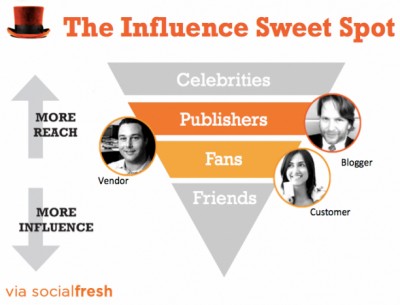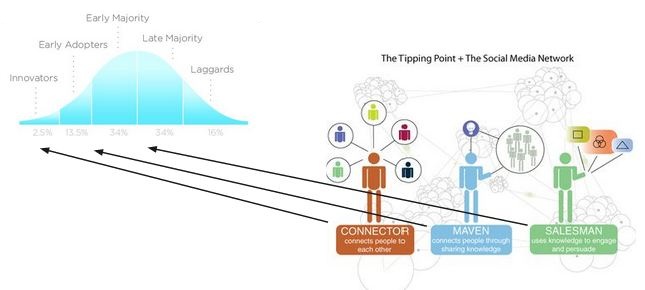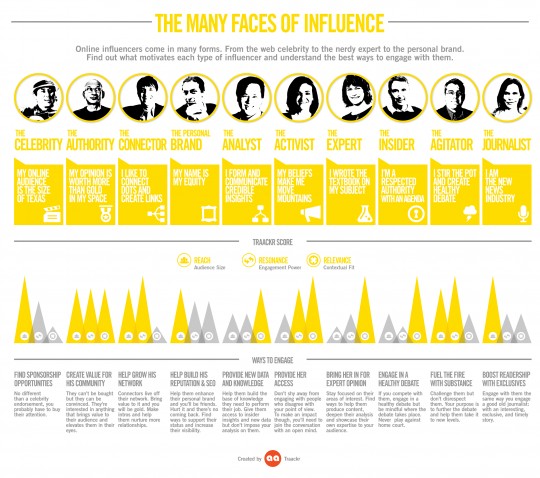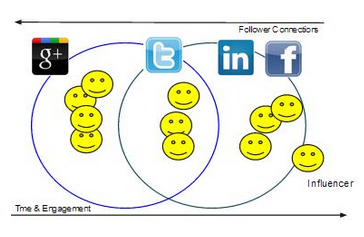At our recent SoundBoard marketing conference in Athens, GA, I gave a presentation on Influence Marketing, a potentially powerful form of marketing that focuses on people and their social connections rather than a market as a whole.
During our talk, I covered strategies and tools to identify and engage target influencers. You can accomplish this using a wide variety of tools; Followerwonk, Traackr, Buzzstream, and Inkybee are just a few.
Identifying influencers is the easy part. The bigger challenge for marketers is how to identify the right type of influencers at the most helpful time, and how to then craft your engagement strategy. That’s as complicated as it sounds and requires a cross-functional approach, which I will describe at a high-level here.
Moving Beyond the Influence Sweet Spot
 As our friends at Social Fresh helpfully illustrate, influence is inverted between reach and influence. Sure, you’ll do whatever your mom tells you to, but outside of your world her powerful influence likely wanes.
As our friends at Social Fresh helpfully illustrate, influence is inverted between reach and influence. Sure, you’ll do whatever your mom tells you to, but outside of your world her powerful influence likely wanes.
Targeting that optimal sweet spot between reach and influence is a big part of influence marketing, but your actual engagement depends on both the level of adoption of your products and what your influencers care about.
Why Your Existing Product Adoption Stage Matters
When developing your influence marketing strategy, it is useful to consider how Malcolm Gladwell’s influencer types align with your existing product adoption levels. Doing so can help you prioritize who you should approach and how.
Whether you’re a startup lacking a big brand name or a Fortune 500 with a new product, the product adoption curve applies.
Even the most fantastic, seemingly overnight successes (i.e. Twitter, Instagram) still cycle through the adoption curve, which involves influencers of different types to adopt and disseminate information about a particular product or service. Understanding those influencers types and how they relate to each other is the first step to finding them and enlisting their help.
“Connectors” are your innovators; they see your vision and help bring together the right minds to get a project off the ground. “Mavens” help spread the news, and “Salesmen” persuade others to join the party.
This is not absolute; certainly all types of influencers could be useful at any stage. However, since the nature of your needs vary in every stage, so too should your strategy. Once you know why you are reaching out to a particular influencer, you can consider what they care about.
Tailor Your Engagement Strategy
Influencers come in all shapes and sizes, but mostly they tend to fall into a certain influencer category. As the excellent infographic below showcases, what type of influencer someone is can significantly change their reach, resonance, and relevance. It also sheds important insight into what they care about. That’s all incredibly useful information in terms of how you engage them, and when properly deployed can dramatically affect your success rate.
Before Engagement, a Credible Courtship
Unless you are yourself a big deal influencer of some sort, chances are a big deal influencer is going to mentally mark you as a spammy creepster if you move too fast in your influence courtship.
 Typically, a long-term goal of influence marketing is to add relevant influencers to your network so they are exposed to your offerings over time. That’s why a strategy of “let’s be friends first” is a great bet. Of course, if you’re not credible or come on too strong, why would your influencer want to connect?
Typically, a long-term goal of influence marketing is to add relevant influencers to your network so they are exposed to your offerings over time. That’s why a strategy of “let’s be friends first” is a great bet. Of course, if you’re not credible or come on too strong, why would your influencer want to connect?
Becoming credible to the point of successfully digitally “friending” an influencer takes time, content, and engagement, but not necessarily with your target. What does your target influencer care about, and who does she follow? What do those folks care about? Consider sharing content they’ll appreciate, then following and promoting them. Because Google search results are influenced by people in your network, G+ is a particularly great tool for this.
As you close in on your target, continue to tailor your content, promote, then, finally — engage!
Image 1 via Social Fresh.
Image 2 via Everett Rogers and edREV21.
Image 3 via Traackr.

